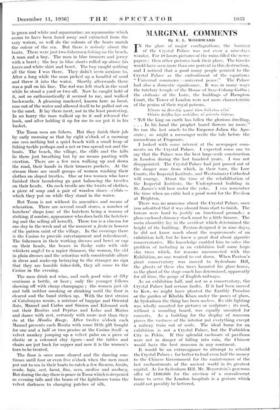MARGINAL COMMENTS
By E. L. WOODWARD
Etrare 74; filiTLA. XL11.11Lt 74tre 8aatAtiv at■Xli • W.KiTL 4101/30g ;XEL KLEA.0111', OP 441716U EIC141711% " Tell the king on earth has fallen the glorious dwelling. . . . In his hand the prophet laurel flowers no more." So ran the last oracle to the Emperor Julian the Apo- state ; so might a messenger recite the talc before the mausoleum at Froginore.
I looked with sonic interest at the newspaper com- ments on the Crystal Palace. I expected some one to say that the Palace was the best large-scale construction in London during the last hundred years. I was not disappointed. The Crystal Palace had just passed out of the danger zone from which, in their turn, the Law Courts, the Imperial Institute. and Westminster Cathedral will emerge. About the time of the rehabilitation of the Imperial Institute, the Underground building in St. James's will bow under the yoke. I can remember the time when no critic had a good word for the Pavilion at Brighton.
There was no nonsense about the Crystal Palace, once you admitted that it was absurd from start to finish. The towers were hard to justify on functional grounds ; a glass-enclosed chimney stack must be a little bizarre. The main absurdity lay in the accident which determined the height of the building. Paxton designed it in nine days; he did not know much about the requirements of an exhibition hall, but he knew a great deal about gigantic conservatories. His knowledge enabled him to solve the problem of including in an exhibition hall some large elm trees which, for reasons unconnected with the Exhibition, no one wanted to cut down. When Paxton's giant conservatory was moved to Sydenham the ghosts of these elm trees haunted his glass house, as the ghost of the stage coach has determined, apparently for all time, the gauge of English railways.
As an exhibition hall, and not as a conservatory, the Crystal Palace had serious faults. If it had been moved to Kew, we might have planted the Earthly Paradise or the garden of Khubla Khan under the panes of glass. At Sydenham the thing has been useless. Its side lighting was wholly unsuited for pictures or sculpture ; its roof, without a sounding board, was equally unsuited for concerts. As a building for the display of museum pieces the vastness of the interior put everything except a railway train out of scale. The ideal home for an exhibition is not a Crystal Palace, but the Forbidden City in Pekin. If this splendid enclosure of pavilions were not in danger of falling into ruin, the Chinese would have the best museum in any continent.
It would be an extravagance to attempt to rebuild the Crystal Palace ; far better to lend even half the money to the Chinese Government for the maintenance of the last enchantments of the ancient world in its greatest capital. As for Sydenham Hill, Mr. Meyerstein's generous offer of £100,000 for the erection of a convalescent home to serve the London hospitals is a gesture which could not possibly be bettered.
















































 Previous page
Previous page